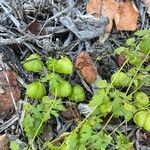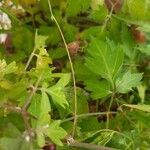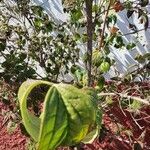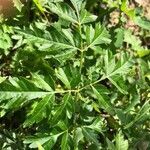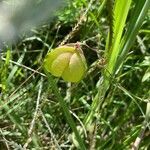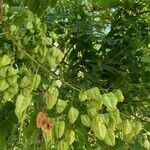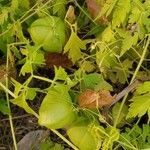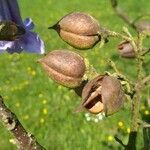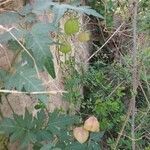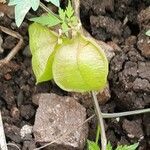Annual herbaceous or slightly woody climber, 0.3–3 mm. long; stems deeply grooved, straw-coloured with grooves green.. Leaves pale green, stipulate, thin, biternate, triangular in outline, (3–)5–10 cm. long, 5–12 cm. wide, composed of 3 ± equal divisions each of a petiolule and 3 leaflets or deeply trifid leaflet; petiole 0.4–6 cm. long, pubescent; first order petiolules 0.5–3 cm. long, subequal or often the lateral ones somewhat longer than median one; leaflets sessile or with short secondary petiolules, sparsely pubescent when young, later glabrescent except for main nerves, the terminal one ovate, 1.5–6.5 cm. long, 0.8–2.5 cm. wide, acute to acuminate or rarely rounded at the apex, apiculate, attenuate to rounded at the base, serrate to deeply dentate or pinnatipartite, rarely ± entire.. Inflorescences corymbose, the rhachis bearing 3–4, 2–5-flowered raceme-like thyrses; peduncle below tendrils 1.5–10.5 cm. long, the part above 0.2–1.2 cm. long; secondary peduncles 0.3–1.7 cm. long; pedicels (0–)1–2 mm. long, lengthening to 5 mm. in fruit.. Flowers said not to be scented; sepals yellow-green, unequal, the outer ± round, 1 mm. diameter, the inner larger and ovate, 2–3 mm. long, 1–2 mm. wide; petals white, cream, greenish or yellow, elliptic to obovate, 2–3 mm. long; appendages yellow at tip, hairy; disk of 2 curved elements 1 mm. long.. Stamens 8; filaments ± 2 mm. long, pilose.. Ovary ± 2 mm. diameter; style 0.5 mm. long, with yellow stigma equalling it.. Fruit yellow-green turning greenish brown to reddish or dark brown, obtetrahedral, 1–3.5 cm. long, 1.8–4 cm. wide, dehiscing into 3 segments, at first densely puberulous or pubescent.. Seeds black, globose, 5 mm. diameter, with a reniform or crescentic hilar area, 3–4 mm. wide.. Fig. 25/1–4.
Climbers, herbaceous, 1-1.5 m. Stems and branches green, 5-or 6-sulcate, slender, glabrous or sparsely hairy. Leaves biternate, triangular in outline; petioles 3-4 cm; leaflets subsessile; blades thinly papery, margin sparsely serrate or pinnately parted, abaxially sparsely villous on midvein and lateral veins, adaxially subglabrous or sparsely pilosulose; terminal blade obliquely lanceolate or subrhombic, 3-8 × 1.5-2.5 cm, apex acuminate; lateral ones slightly smaller, ovate or narrowly elliptic. Panicles few flowered, ca. as long as or slightly longer than leaves; peduncles straight, 4-8 cm, tendrils spiralled. Sepals 4, ciliate, outer 2 ovate, 8-10 mm, inner 2 narrowly elliptic, ca. 2 × as long as outer ones. Petals milky-white, obovate. Stamens (male flowers) ca. as long as or slightly longer than petals; filaments sparsely long villous. Ovary (female flowers) obovoid or sometimes subglobose, pubescent. Capsules brown, pearlike, turbinate-obtriangular or sometimes nearly ellipsoid, 1.5-3 × 2-4 cm, pubescent. Seeds black, shiny, ca. 5 mm in diam.; hilum green when fresh, white when dry, cordate. Fl. summer-autumn, fr. autumn-early winter.
Annual vines; stems 5-or 6-ribbed, glabrous or minutely pubescent. Leaves biternate; leaflets oblong to ovate, obtuse or subacute at apex, attenuate or acute at the base, 2-8 cm long, 1-2.5 cm wide, deeply incised-dentate, membranous, pubescent or glabrate; stipules subulate, small. Thyrses long-pedunculate on a tendril, umbellike in appearance. Flowers yellowish white, mostly 4-5 mm long; sepals 4, the outer 2 small, pubescent, the inner 2 large, glabrous, oblong, ca. 4 mm long; petals obovate, attenuate, equal to the inner sepals, the scale round, to 2.5 mm long, the deflexed appendage oblong, villous especially along the mar-gins, the crest obovate, orange; disc with 2 conspicuous suborbicular, glabrous glands 0.5 mm long; filaments pilose, those of the staminate flowers to 3.5 mm long. Capsules subglobose, 3-lobed, 3-4 cm long, membranous, inflated, pubes-cent, green to brown or reddish brown; seeds globose, black, 5 mm long, the hilum large, bilobed.
Slender trailing vine; glabrous, or stems, leaf axes and peduncles puberulous. Leaf rachis 1–2.5 cm long; pinnae 2.5–6.5 cm long, 2–7 cm wide; secondary petioles 0.5–1 cm long; leaflets with lamina elongate-ovate, acuminate or acute, irregularly dentate or pinnatifid, 1.5–3.5 cm long, 0.7–1.8 cm wide, puberulent or glabrous; petiolules 2–7 mm long; petiole 1.5–5.5 cm long. Inflorescence umbel-like with 3 or 4 raceme-like branches; peduncle 2.5–14 cm long; tendrils 1 or 2 pairs; pedicels 2–3 mm long. Sepals 1–4 mm long, 1–2 mm wide. Petals c. 3 mm long, c. 1.5 mm wide; posterior pair with puberulent scales and crests, white. Disc small, swollen. Fruit subglobose, pyriform or obovoid, 1–3 cm long, pubescent or puberulent. Seed 3–5 mm diam.; aril 2-lobed.
A straggling vine or climber. It can be an annual or perennial. It has a woody base and tendrils. It grows 3-5 m long. The stems are angular and very hairy. The leaves are 15-20 cm long. The leaves have 3 leaflets. The leaflets have 3 lobes which are oval and have coarse teeth. They are light green, thin and hairy. The leaflets are 0.5-2 cm wide. The flowers have 4 white petals. The flowers are borne in groups of 3 or 4. The flowers are 7 cm long. The flowers have a delicate scent. The fruit is a 3 cornered, balloon-like capsule with 6 prominent ribs. They are pale green and become papery when ripe. They are 2-3 cm long. They split to release 1-3 black seeds. The seeds are 5 mm across. They are attached to the centre of a papery wing.
Leaves biternate, triangular; petiole (0·5)0·9–3·5 cm. long; rhachis 0·4–2 cm. long; terminal leaflet 2·5–4·5(6) × 0·7–2 cm; lateral leaflets 2·5–4·5(5) × 0·8–2(3·5) cm.; lamina bright green with a paler under surface, only the main veins raised, apex acuminate, margin incised-serrate, base attenuate; stipules 2 minute caducous scales.
Much-branched, to 2 m; lfls ovate, incised, cuneate to the base; fls white, 5 mm wide; fr globose to ovoid, 3–4 cm thick; 2n=22. Native of trop. Amer., escaped from cult. in se. U.S. and occasionally n. to N.J., O., Ill., and Mo. Summer.
In var. microcarpum (Kunth) Blume (see Radlk. l.c. 387) the fruits are 1–2 cm. long, but as so many specimens lack mature fruits the varieties are not separated in the following citation.
Annual, herbaceous or slightly woody climber. Leaves 2-ternate, leaflets incised-serrate. Flowers 2-6 mm long. Fruit obversely tetrahedroid. Flowers white.
Annual straggling minutely puberulous herbaceous or slightly woody climber, sometimes flowering when only 25 cm. tall; stems with internodes 4–7 cm. long.
Inflorescence a reduced complex axillary corymbose thyrse, abortively 3-flowered; peduncle 4–9 cm. long, very sparsely puberulous, multi-bracteate.
Petals 4–5 mm. long, posterior ones bearing recurved clavate appendages provided with hairs which cause the two free ends to cohere.
Stamens with filaments 3 mm. long, free or slightly connate at the base; anthers 0·5 mm. long.
A slender climber, like the last (Cardiospermum grandiflorum), but with much smaller flowers
Sepals with lateral ones c. 1 mm. long, anterior and posterior ones c. 3 mm. long.
Ovary hirsute; style-branches clavate, shortly plumose.
Flowers white to yellowish, 2–3 mm. long.
Seed 5 mm. in diam., reniform.
